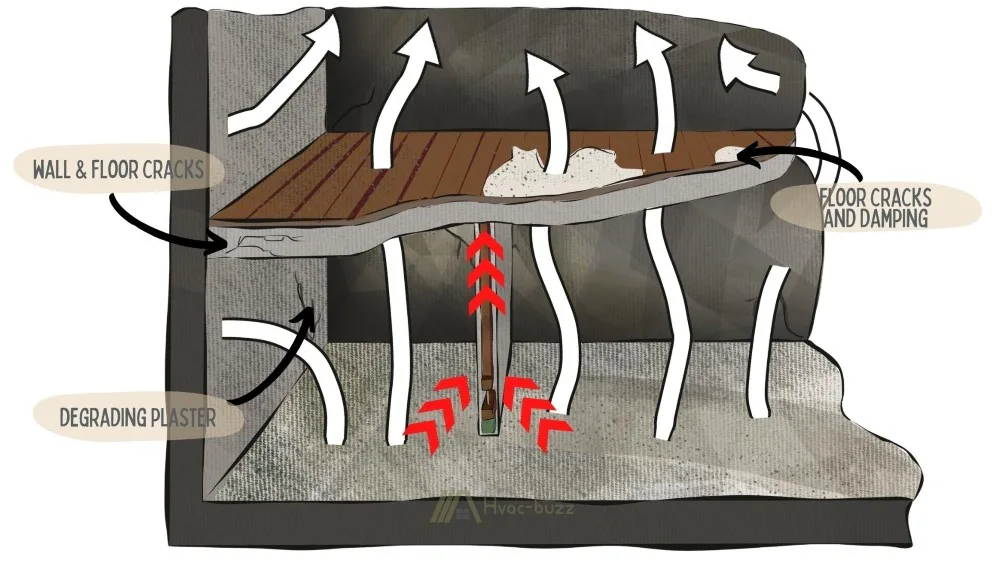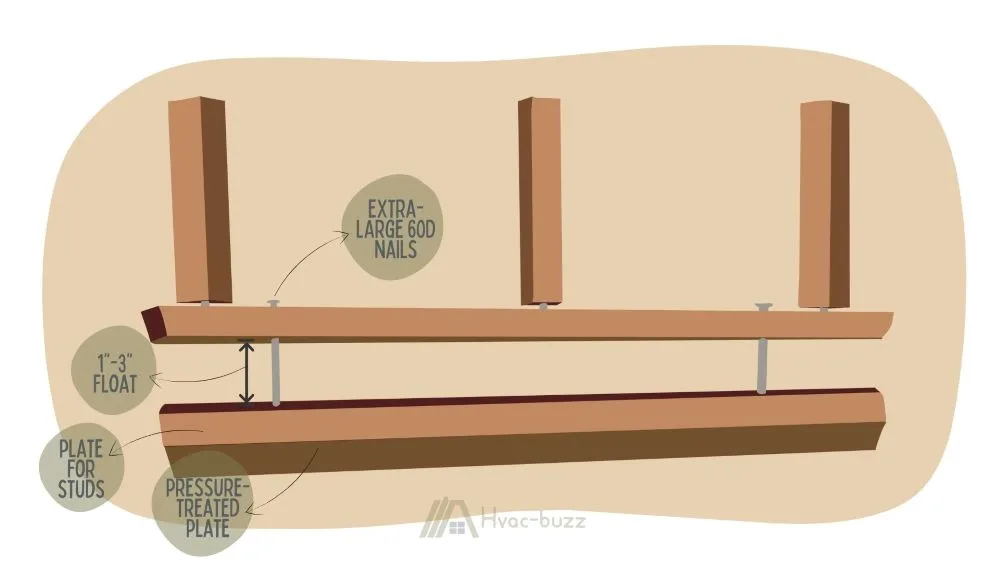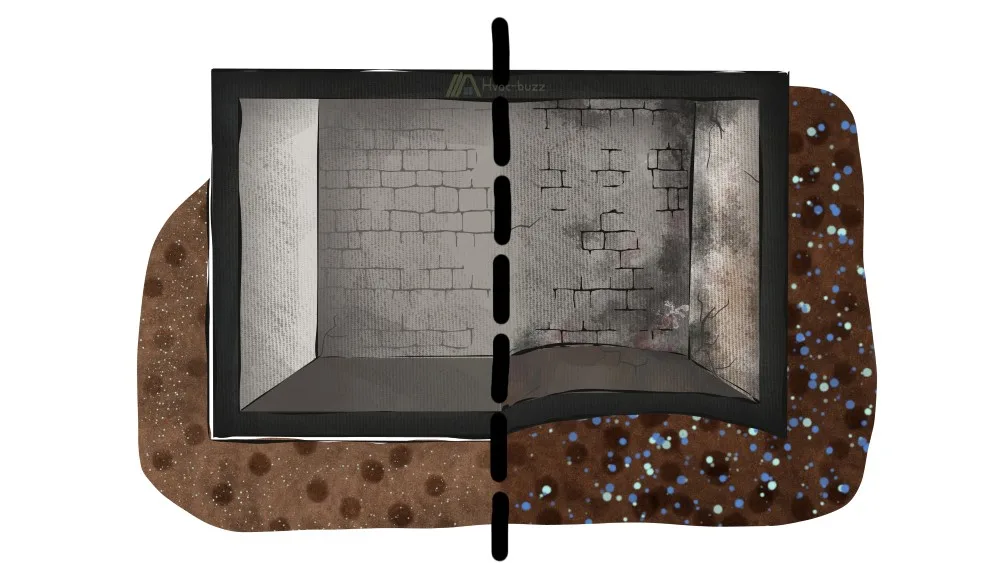I only recently stumbled across the concept of floating walls and it baffled me as to what they could be. After some research, however, the name didn’t seem so strange. The idea is actually quite a sound one, although the application of floating walls seems to be quite restricted.
Floating walls are only required in basements, not other parts of the house. They are only required in some states and areas, and they are only required for interior, non-load-bearing walls. Now that you know the general information, let’s get into some details.

Floating basement walls are required in areas that have high clay content in the soil, making the ground expansive. Colorado, Wyoming, Saskatchewan, and Winnipeg are some of the areas that often require floating walls. Only interior non-load-bearing basement walls can be floated.
What Is the Purpose of Floating Walls?
Floating walls prevent strain on your walls when the ground around the house foundations expands and contracts. The walls are attached to the ceiling with a 2″ gap between the bottom of the wall and the floor. This gap gets larger as the floor contracts and smaller as it expands.
Floating walls are notably required in Colorado, where the soil has a large content of clay, specifically Bentonite, in the soil. This clay is known to greatly expand when wet, which can exert a force on the basement floor of a home.
Without floating walls, this pressure would push the basement walls up and potentially damage the floor of the next level and damage the walls of that level and all levels above. So, floating walls prevent ground expansion from straining the walls of your basement and home.

When the ground heaves, it will no longer impact the structural integrity of the home if the walls are floated. Some cracks and damage may occur, but it will be less serious than without the floated walls.
How Do Floating Walls Work?
Floating walls unlike regular basement walls do not sit directly on the floor slab. Instead, they sit between pressure-treated plates of 1-3″ and are anchored with extra-large 60D nails. This arrangement allows the wall to move slightly to accommodate any slab movement that might ensue due to changes in climate and temperature conditions of the soil.

Non-floating walls in vulnerable locations can push up the ceiling and floor joist when the soil becomes saturated. This causes significant damage not only to the basement but also to structures above and throughout the home over time.
If your basement is properly framed with floating walls, the few add
IRC Does Not Cover Floating Walls
There are no official building codes for floating walls in the International Residential Code (IRC) because not all places need floating walls. Only regions with highly expansive soil need floating walls to accommodate this, so these areas have local building regulations for them.
States/Areas Requiring Basement Floating Walls
Colorado is the most well-known state that requires floating basement walls as per their building codes. This requirement is due to the high concentration of Bentonite in the soil.
Floating Walls Required in Colorado Basements
A study by the Colorado Geological Survey (CGS) estimates that the nation loses about $2 billion annually as a result of damages caused by expansive soils!
Many regions in Colorado feature soils that are laced with expansive clays. The most popular is Bentonite, a type of clay that can absorb a significant amount of water molecules. This results in swelling when the moisture content is high and shrinkage as it reduces.
How Does Bentonite Affect Buildings?
According to the Wyoming State Geological Survey (WSGS), Sodium Bentonite can absorb 10 times its weight in water. It can also expand up to 16% of its size. This feature makes builders adopt it as a foundation waterproofer.
However, in areas like Colorado, where this expandable clay is already present in the soil, adequate procedures are to be followed in order to avoid serious structural issues like:
- Broken foundations.
- Cracked drywall.
- Heaved floors that lead to cracks.
- Damage to basement structures.
- The building can also be completely destroyed in extreme situations.
If expansive soil is found in clay, a pier-supported foundation an
Colorado codes state that non-bearing basement walls should allow for a gap of no less than 1½” between the wall and floor. It is recommended that nails be placed every 24″ along the bottom of the wall, securing them to a pressure-treated floor plate.
Other Areas
Other areas of the US with highly expansive soil have city regulations surrounding floating walls.
The Wyoming cities of Casper and Gillette both recommend floating basement walls to accommodate for soil conditions. Check your city building codes for more information about requirements near you.
If nothing is stated in your local codes about floating basements, ask around to see if they are common in your area. You can also determine how expansive the soil in your area is by checking this map.
Keeping water out of the ground can be more of a challenge than building more stable constructions to withstand the moving ground. Floating walls are a workaround that allows soil expansion while protecting the interior structure of buildings.

Floating walls are common in areas of Canada, such as Saskatchewan and Winnipeg. They are recommended in Winnipeg according to their building codes, which suggest a 1″ gap at the top or bottom of all walls.
Do All Basement Walls Need to Be Floated?
Only interior and non-load-bearing walls of basements are floated. This makes it a necessary consideration if you are finishing your basement. Load-bearing walls need to be rigidly secured to the concrete foundation to provide structure for the home. Floating these walls would lower their load capacity, making them a structural hazard.
While exterior walls are rigidly attached to the foundation, interior walls in areas susceptible to soil expansion need to be floated. Floating the interior walls prevents damage to the home when soil expands by isolating them from the foundation.
Additionally, no walls need to be floated if your home is not in an area with potential ground heaving. Walls only need to be floated if the soil in the area has a large concentration of Bentonite or another expansive clay.
Floating walls should be considered if you have already noticed damage such as drywall or floor cracking and buckling as these can be signs of soil expansion.
Drainage of runoff can be another controllable factor when it comes to preventing soil expansion by keeping the ground beneath your house dry. If your drainage system does a good enough job, you may not need to float your walls even if you are in an area with expansive soil.
How Do Floating Walls Work?

Floating walls consist of your standard basement wall in addition to a bottom plate (a wood beam), which runs along the bottom of the wall, a pressure-treated 2×4 wooden floor beam, and several 40d nails.
Wood floor plates are secured on the floor beneath all walls. The basement wall frames are hung from ceiling joists so that they are floating 1-3″ above the floor plates. 40d nails are nailed down from the bottom plate to the floor plate at least every 24″ along the walls to secure the walls from horizontal movement.
Floating walls are finished with normal wall finishing materials, such as drywall and paint, and spacers can be used on the edge of floor plates so that they match the look of the wall above them.
The floor plates are attached to the basement floor slab, which is a separate concrete slab from your house’s foundation underneath. This allows the floor slab to buckle and crack without causing damage to the foundation.
Without floating walls, when pressure is exerted upwards from expanding soil, it can push basement walls up into the ceiling joists causing cracks in the drywall and compromising the structure of these and other walls in the upper levels of the home.
Floating walls remain steady when pressure is exerted upwards and only the floor plate is pushed up without damaging the wall above it. If damage is caused, it is usually superficial such as cracked tile rather than a structural issue.
If Walls Are Not Floated, Must I Fix Them?
If you notice damage related to a non-floated wall in a non-Colorado basement, then you should investigate the option of floating them. There are no drawbacks to having floating walls as a precaution if you have the time and effort needed to install them.
If you live in Colorado, your basement will not be code-compliant if you leave them. Colorado building codes require that single-family residential basements have floating basements.
Other areas of the United States, such as Wyoming, have recommendations for floating walls, which are important to note as well.
If your city has no codes regarding floating walls, it may be useful to research ground clay content in your area to determine if floating your walls is necessary. If the soil is not particularly expansive, you can save time and money by leaving your walls as they are and do not need to be concerned with damage to your property.
Sources
https://homefixcos.com/frame-basement-colorado-springs/
